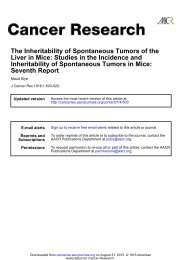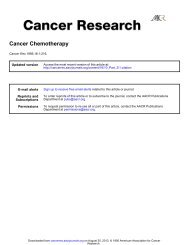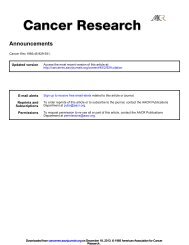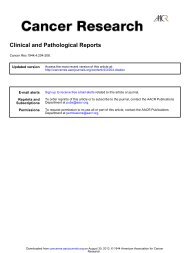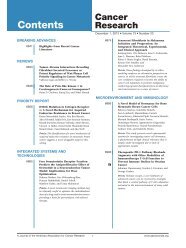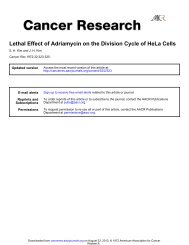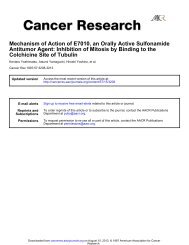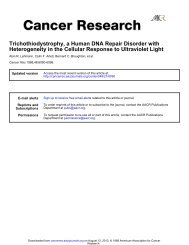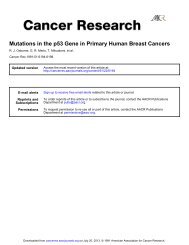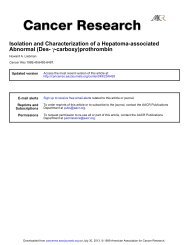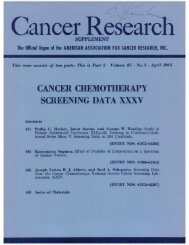XANTHOMA OF THE BREAST In a series of nine hundred (circa ...
XANTHOMA OF THE BREAST In a series of nine hundred (circa ...
XANTHOMA OF THE BREAST In a series of nine hundred (circa ...
You also want an ePaper? Increase the reach of your titles
YUMPU automatically turns print PDFs into web optimized ePapers that Google loves.
Downloaded from cancerres.aacrjournals.org on December 28, 2013. © 1932<br />
American Association for Cancer Research.<br />
<strong>XANTHOMA</strong> <strong>OF</strong> <strong>THE</strong> <strong>BREAST</strong> 1087<br />
Treatment: The patient was seen in consultation by Sir Lenthal<br />
Cheatle, who advised interstitial radiation. Accordingly, on Aug. 26,<br />
1930, and during the following days, six needles containing a total <strong>of</strong> 85<br />
millicuries <strong>of</strong> radon filtered by 0.3 mm. <strong>of</strong> gold and 0.2 mm. <strong>of</strong> steel were<br />
inserted into 18 sites about the periphery <strong>of</strong> the tumor and allowed to<br />
remain in situ until a total <strong>of</strong> 7,200 milicurie hours had been delivered to<br />
the tumor.<br />
Ten weeks later, Nov. 5, 1930, there was a marked decrease in the size<br />
<strong>of</strong> the tumor. A reaction, limited to reddening and slight desquamation<br />
<strong>of</strong> the overlying skin, had occurred. The central area <strong>of</strong> s<strong>of</strong>tening was<br />
less marked.<br />
By March 12, 1931, seven months after the radiation had been completed,<br />
the contour <strong>of</strong> the breast was almost normal (Fig. 2). The reddish<br />
discoloration <strong>of</strong> the skin had completely disappeared, only slight<br />
post-radiation pigmentation remaining. Of the tumor, only an indefinite<br />
area somewhat more firm than normal mammary tissue remained. Because<br />
it was felt that, although there had been remarkable regression,<br />
a residuum <strong>of</strong> the tumor persisted, a local mastectomy was decided upon.<br />
The diabetes had responded readily to a dietary regime and was not considered<br />
a contraindication. On June 4, 1931, the operation was done,<br />
novocaine infiltration anesthesia being used. Recovery was uneventful.<br />
On discharge the patient was cautioned to continue her dietary<br />
regime. A year later (June 10, 1932) there had been no recurrence <strong>of</strong><br />
the tumor. At that time her blood sugar was 143 mg. The blood<br />
cholesterin was 175 mg., that is within the upper limits <strong>of</strong> normal. It<br />
may, <strong>of</strong> course, be objected that had a blood cholesterin determination<br />
been made at the time the tumor was treated, a year previously, and<br />
before the institution <strong>of</strong> a restricted diet, hypercholesterinemia might<br />
have been found. Kirch, however, in his <strong>series</strong> <strong>of</strong> xanthomatous tumors,<br />
found hypercholesterinemia persisting as late as ten years after operation.<br />
Gross Diagnosis (Pathologic Specimen No. C 4119): A simple mastectomy<br />
has been done. Four centimeters from the nipple there is an<br />
encapsulated, centrally necrotic tumor measuring 6 x 4 x 6 em. Its cut<br />
surface is s<strong>of</strong>t, reddish, and granular, suggesting bulky adenocarcinoma.<br />
Microscopic Diagnosis: The tumor is composed wholly <strong>of</strong> very large<br />
xanthoma cells lying in the interstices <strong>of</strong> a prominent fibrous stroma<br />
(Figs. 3 and 4). The xanthoma cells are round when they lie free and<br />
polyhedral when they lie among the strands <strong>of</strong> fibrous stroma. They<br />
vary between 30 and 50 microns in diameter. The nuclei are comparatively<br />
very small, stain darkly, and are <strong>of</strong>ten eccentrically situated. The<br />
cytoplasm, which makes up the great bulk <strong>of</strong> the cell, is acidophile and<br />
has the characteristic foamy appearance. With higher magnification<br />
this is seen to be due to the presence <strong>of</strong> a fine network in the cytoplasm.<br />
Stained with Sudan III (Fig. 5) this network is seen to contain orangered<br />
cholesterin ester droplets. A few crystals (Fig. 6) surrounded by giant<br />
cells <strong>of</strong> the foreign-body type are seen. Large areas <strong>of</strong> the tumor are<br />
necrotic. The tumor contains no lymphocytic, plasma-cell, or polymorphonuclear<br />
infiltration. No neoplastic elements are seen. The vascular<br />
supply is poor.



